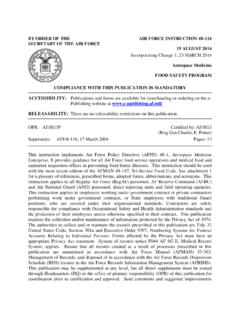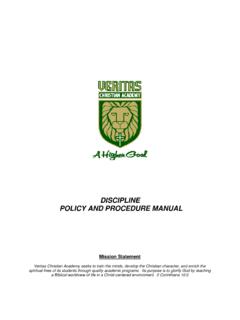Transcription of BY ORDER OF THE AIR FORCE INSTRUCTION 90-821 …
1 BY ORDER OF THE SECRETARY OF THE AIR FORCE AIR FORCE INSTRUCTION 90-821 27 JANUARY 2014 special management HAZARD communication ( hazcom ) PROGRAM COMPLIANCE WITH THIS PUBLICATION IS MANDATORY ACCESSIBILITY: Publications and forms are available for downloading or ordering on the e-Publishing website at RELEASABILITY: There are no releasability restrictions on this publication. OPR: AFMSA/SG3PB Supersedes: AFOSHSTD161-21, 23 January 1989 and AFI90-821, 30 March 2005 Certified by: HQ USAF/SG3 (Brig Gen Charles E. Potter) Pages: 25 This Air FORCE INSTRUCTION (AFI) implements Department of Defense INSTRUCTION (DoDI) , DoD Hazard communication ( hazcom ) Program, and Air FORCE Policy Directive (AFPD) 90-8, Environment, Safety and Occupational Health management and Risk management .
2 It describes the Air FORCE (AF) hazcom Program that puts into effect the requirements of Title 29, Code of Federal Regulations (CFR), Part , Hazard communication . Unless otherwise noted, the guidance and procedures outlined in this AFI apply to all United States Air FORCE (USAF) military and civilian personnel at AF installations and geographically separated units (GSU) within the United States (US) and its territories. For installations and GSUs located in foreign countries, this AFI only applies to the extent it addresses matters not covered by country-specific Final Governing Standards (FGS), the Overseas Environmental Baseline Guidance Document (OEBGD), Combatant Command policy, and environmental consideration annexes to operation orders, operation plans, or other operation directive that apply at the overseas location.
3 Additionally, this AFI applies to the AF Reserve (AFR), the Air National Guard, and direct reporting units (DRU) and field operating agencies (FOA) not located on AF installations. Government-owned, contractor-operated (GOCO) operations within the US or US territories shall implement 29 CFR GOCO operations outside the regulatory jurisdiction of the Occupational Safety and Health Administration (OSHA) shall comply with this standard in response to Federal Acquisition Regulation (FAR) , Hazardous Material Identification and Material Safety Data.
4 Refer recommended changes and questions about this publication to the Office of Primary 2 AFI90-821 27 JANUARY 2014 Responsibility (OPR) using the AF Form 847, Recommendation for Change of Publication; route AF Forms 847 from the field through the appropriate functional chain of command. The authorities to waive wing/unit level requirements in this publication are identified with a tier ( T-0, T-1, T-2, T-3 ) number following the compliance statement. See AFI 33-360, Publications and Forms management , for a description of the authorities associated with the tier numbers.
5 Submit requests for waivers through the chain of command to the appropriate tier waiver approval authority, or alternately, to the publication OPR for non-tiered compliance items. This publication may be supplemented at any level when additional or more stringent safety and health criteria are required. Ensure that all records created as a result of processes prescribed in this publication are maintained in accordance with Air FORCE Manual (AFMAN) 33-363, management of Records, and disposed of in accordance with Air FORCE Records Information management System (AFRIMS) Records Disposition Schedule (RDS).
6 SUMMARY OF CHANGES This document has been substantially revised and must be completely reviewed. Major changes include updates that align the program with the United Nations Globally Harmonized System of Classification and Labeling of Chemicals (GHS). Specifically, changes include terminology, safety data sheet (SDS) format, and labeling requirements. Chapter 1 PROGRAM OVERVIEW 4 Purpose.. 4 Scope.. 4 Hazard Classification.. 7 Chapter 2 ROLES AND RESPONSIBILITIES 8 Assistant Secretary of the Air FORCE for Installations, Environment, and Logistics (SAF/IE).. 8 Assistant Secretary of the Air FORCE for Acquisition (SAF/AQ).
7 8 Air FORCE Surgeon General (AF/SG).. 8 MAJCOMs, FOAs and DRU Commanders.. 8 United States Air FORCE School of Aerospace Medicine (USAFSAM).. 9 Wing/Installation Level Commanders.. 9 Tenant Units.. 12 AFI90-821 27 JANUARY 2014 3 Chapter 3 WRITTEN WORK-AREA SPECIFIC hazcom PROGRAM REQUIREMENTS 13 Written Work-Area Specific hazcom programs .. 13 Attachment 1 GLOSSARY OF REFERENCES AND SUPPORTING INFORMATION 18 Attachment 2 SAMPLE TRADE SECRET INFORMATION REQUEST LETTER 25 4 AFI90-821 27 JANUARY 2014 Chapter 1 PROGRAM OVERVIEW Purpose. Hazardous chemicals are found in virtually every AF operation, including aircraft and missile maintenance, civil engineering, transportation, supply, medical, and support functions.
8 This AFI is intended to minimize the incidence of chemically induced occupational and environmental health-related illnesses and injuries by establishing guidance for training employees on the health and physical hazards associated with and proper preventive measures to be taken when using or handling hazardous chemicals in work areas. Scope. This AFI provides the requirements for an effective AF hazcom Program for those work areas that have workers that handle or use hazardous chemicals. All employees that work in an environment where hazardous chemicals are known to be present in such a manner that employees may be exposed under normal conditions of use or in a foreseeable emergency, will be provided information about the hazardous chemicals to which they may be exposed.
9 This information shall be provided by means of a written work area-specific hazcom program, including but not limited to SDSs (formerly known as Material Safety Data Sheets or MSDSs), labels, and other forms of warning, information and training. This AFI applies to: All AF military and civilian personnel at AF installations, GSUs, and GOCO operations in the US and US territories. For installations located in foreign countries, this AFI only applies to the extent it addresses matters not covered by country-specific FGSs, the OEBGD, Combatant Command policy, and environmental consideration annexes to operation orders, operation plans, or other operation directive that apply at the overseas location.
10 The AF Reserve, the Air National Guard, and DRUs and FOAs not located on AF installations. All AF military and civilian personnel who use, handle, or may be potentially exposed to hazardous chemicals while working under a contractor or working in contractor facilities. The AF retains ultimate responsibility for AF personnel participation and oversight. Contractor employees who are employed at AF-owned or operated facilities that may be exposed to hazardous chemicals used during an AF operation with the following exceptions: This AFI does not excuse contractors, as stipulated in their specific contracts, from their compliance obligations under 29 CFR or any applicable State and local requirements.














